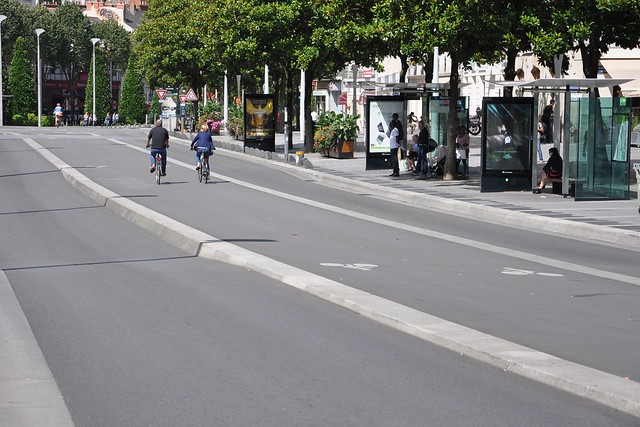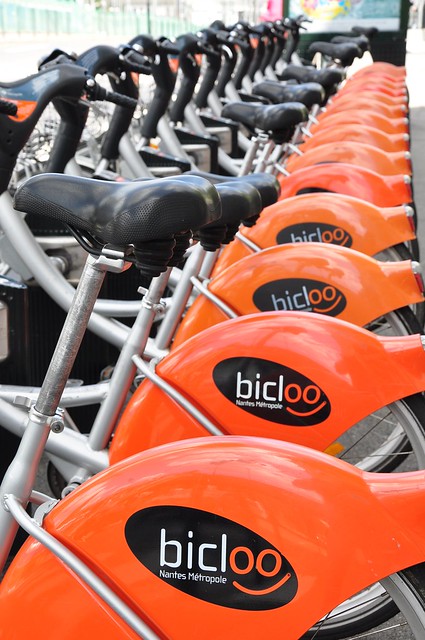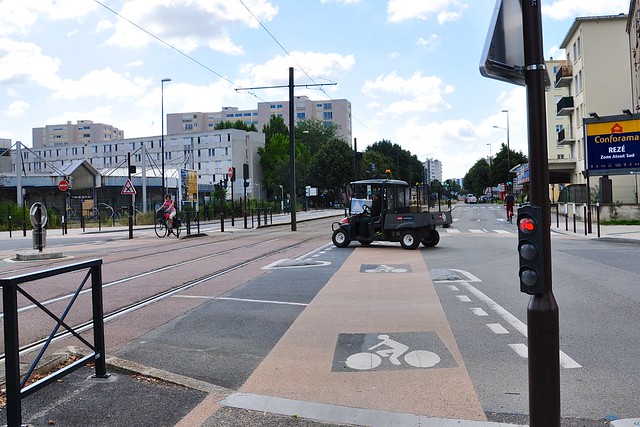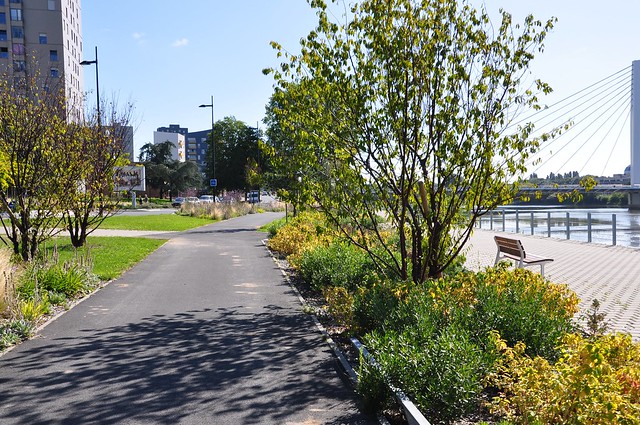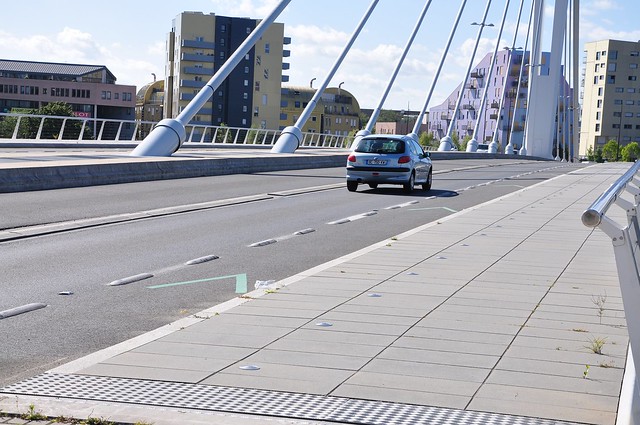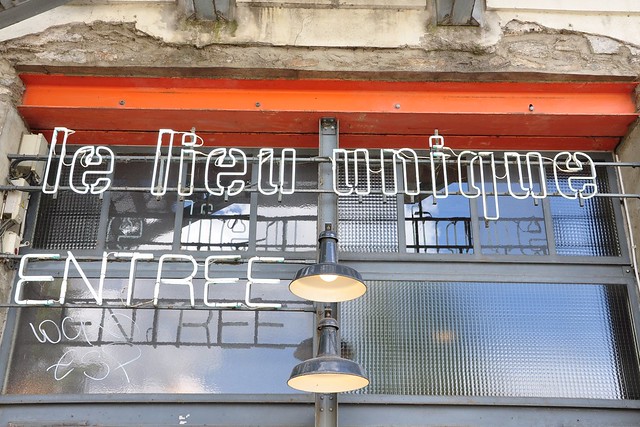
A French translation of this article follows the English text.
The city of Nantes in France will host the global bicycle conference Velo-City in June 2015. Before showing up, Copenhagenize Design Company decided to do a scouting tour.
Nantes and its 600,000 inhabitants - including the immediate suburbs - is one of the French cities that decided to implement an ambitious cycling policy. They dared to innovate and to make strong political decisions. We find that inspiring.To begin with, watch the Velo-City 2015 promotional clip. In this video, Nantes demonstrates that they understand that creating a bicycle-friendly city is not just about building infrastructure but it's most of all about developing a life-sized city where bicycles are merely one of the tools to create an active, creative and liveable city - albeit one of the most important tools. Nantes presents in the video its inhabitants, its urban spaces and its activities.
We have to admit that we have been impressed by the diversity of features included in the bicycle policy. Far from being only focused on building infrastructure, Nantes expands the initiatives to include everything that can support rebuilding a bike-friendly city; services for cyclists; parking; a bike share programme; long and short term rental bikes; collaboration with the local associations, etc.The implementation of their policy has been a success if you consider the fact that the number of cyclists has increased and the modal share rose from 2% to 4.5% between 2008 and 2012 (5.3% in the city-centre). Most importantly, the bicycle users in the city are largely Citizen Cyclists and not hard-core "avid cyclists" dressed in racing gear.
First step - Reducing the Number of Parasites
During rush hour, many streets are still highly congested but when it comes to traffic regulation within the city-centre, Nantes has made a crucial decision: the through traffic has been completely removed from the heart of the city thanks to the creation of a Limited Traffic Area.The main boulevard running through the city is now only accessible to bicycles, public transport and authorised vehicles (taxis, delivery trucks, shopkeepers), meaning that most cars and motorcycles are no longer welcome. On this boulevard, just like on a pedestal, cyclists ride a 4 meter wide cycle track, slightly elevated. Even if we can criticise the fact that the cycle track is very different from the others (bi-directional, in the middle of the street, elevated), we notice that the Municipality has decided to showcase to the inhabitants that the cyclists are very welcome in Nantes - and prioritized. In addition, the city continues transforming symbolic car-centric places into pedestrian areas (such as the Royale square and the Graslin square). Nantes is Copenhagenizing and modernising itself.
 Building Several Kilometres of Bicycle Infrastructure
Building Several Kilometres of Bicycle Infrastructure
In addition to their wider focus, Nantes has, bien sur, built numerous kilometres of separated bike lanes. The colour chosen for the bike lanes is a very light orange. At the intersections, this colour communicates clearly that the space is dedicated to cyclists and orange stripes along the lanes strenghten this communication in some areas.
But let's look at the infrasturcture in detail because it is the backbone of any cycling city. The lanes are wide enough to host the current number of cyclists (3 meters wide for the bi-directional lanes). But when the modal share will really increase, will it be sufficient to cope with the user's flow and capacity? Is the infrastructure capable of evolving and expanding? We're not sure.
A Clear Strategy Can Still Suffer from Drawbacks
We must mention that one clear drawback and that is a lack of homogeneity in the bicycle network. The diversity the design of the infrastruture is such that without a strong knowledge of the city, you can easily lose track of the network. For instance, bicycle lanes are randomly designed. They are in the middle of the street, on the right of car traffic, on the right or left of the tram, shared with buses or pedestrians suddenly for a few metres, first monodirectional then bidirectional. It's a guessing game at times.
Despite the consistency of the orange colour and the creation of two main routes - north-south and east-west- the network remains very complex and not at all intuitive. It makes it quite difficult to get a clear mind map of the bike route you’ll be riding. Moreover, the bi-directional bike lanes already show some limits as this infrastructure is too narrow to host the cyclists at the intersections during rush hour.
The physical complexity of the bike infrastructure has two main impacts. First, the speed of the cyclists is reduced, which turns cycling into a less competitive solution compared to other means of transport (12 km/h in Nantes vs. 15,5 in Copenhagen and 20 km/h on the “Green Wave Routes”). We know for a fact that a bicycle user wants to ride from A to B as quick as possible.
Secondly, the difficulty to visualise a clear cycling itinerary can become a serious deterrent to getting new cyclists onto the infrastructure. This might challenge the ambition of the city to increase the modal share. Can Nantes really reach their declared target of 15% model share for cyclists without making cycling the most practical and easiest choice? Not likely, as it is now.
This challenge is common in many French cities that, on the one hand, develop ambitious cycling networks but, on the other hand, make them too inconsistent when it comes to the type of infrastructure.
Increase the
Diversity of ServicesLike so many French cities, Nantes implemented a bike share scheme – the Bicloo – relying on user-friendly stations (880 bikes and 102 stations). But the city also offers the commuters the opportunity to combine bicycle and train through the development of a bike-train-bike concept (similar to the BiTiBi project). Indeed, let's imagine that an inhabitant of Nantes Métropole cycles from home to a nearby suburban train station, he/she can park the bike under a shelter (or, even better, in a secure bike parking facility at the main train station in Nantes). Then, he/she gets on the train and upon arriving in the city-centre, he/she can rent a bike for a day and return it to the same place before taking the train home. The City of Nantes has also developed secure bike parking, long term rentals and air pumps and they allow folding bike on the trams – the Cyclotan - as well as offering citizens €300 euros subsidy for buying a cargo bike. allowance when buying a cargo-bike.
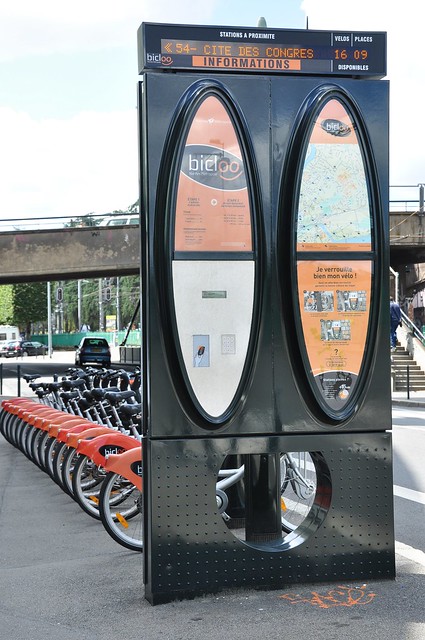

Important information for our followers attending Vélo-City 2015 - we have already found the Copenhagenize HQ - near the conference venue. A lovely place on the Erdre river. See you there in June 2015.
VERSION EN FRANÇAIS
Nantes – Une ville qui a compris !
La Ville de Nantes (France) accueillera en Juin 2105 la conférence mondiale Vélo-City. Avant de venir y participer, Copenhagenize a décidé d'aller y faire un petit repérage.
Nantes, 600.000 habitants à l'échelle de l'agglomération, est l'une des villes françaises qui a mis en place une ambitieuse politique cyclable et qui n'a pas hésité à innover en la matière et prendre des décisions politiques fortes. De quoi inspirer.
Pour commencer, visionnage de son clip de présentation de Vélo-City 2015, où Nantes montre qu'elle a compris que créer une ville cyclable c'était avant tout créer une ville humaine où les vélos ne sont finalement qu'un des éléments d'une ville active et agréable à vivre. Nantes y présente majoritairement ses habitants, ses espaces publics, ses activités urbaines.
Ensuite, il faut bien avouer que nous avons été impressionné sur la diversité des éléments de sa politique cyclable. Loin de s'être uniquement focalisée sur la construction de pistes cyclables, Nantes a élargi ses initiatives concernant le vélo sur tous les fronts : services aux cyclistes, parkings, vélos publics, travail avec les associations locales...
Résultat, la part modale du vélo est passée de 2 % à 4,5 % entre 2008 et 2012 (5,3% dans le centre-ville), mais surtout les cyclistes sont des usagers de la rue comme les autres et non des hard-core du vélo, de vrais « Citizen Cyclists » (cf. le blogpost sur Copenhagen Cycle Chic).
Deuxièmement, des kilomètres d'infrastructures cyclables
Nantes a construit des kilomètres de pistes cyclables complètement séparées de la circulation automobile. Orange pâle, c'est la couleur choisie pour marquer les pistes cyclables. Aux carrefours, cette couleur affirme la place des cyclistes et des bandes peintes le long des pistes vient parfois judicieusement renforcer la lisibilité du réseau.
Les pistes sont actuellement assez larges pour accueillir les cyclistes (3 mètres de large mais en bi-directionnelle), mais qu'en sera-t-il quand le nombre de cyclistes augmentera véritablement. Toutes ces infrastructures seront-elles adaptables?
Une ombre au tableau
Toutefois, il faut tout de même signaler un bémol : le manque d'homogénéité du réseau cyclable. La diversité du type de pistes cyclables est telle que sans être un fin connaisseur de la ville, on en perd très vite la lisibilité. La piste cyclable se situe parfois au centre de la rue, parfois à droite des voitures, à droite ou à gauche du tram, partagée sur quels mètres avec les piétons ou les bus, elle peut-être mono- ou bi-directionnelle...
Le réseau est trop complexe et malgré la signalisation des axes majeurs nord/sud et est/ouest, difficile d'avoir une carte mentale claire de son itinéraire. Par ailleurs, les pistes cyclables bi-directionnelles montrent déjà leur limite aux heures de pointes, les endroits d'attente aux intersections autant rapidement saturés.
La complexité physique du parcours alternant entre différents types de pistes cyclables à deux impacts majeurs. Il réduit la vitesse des cyclistes et rend ainsi ce mode de déplacement moins compétitif face aux autres modes de transport (12km/h à Nantes contre 15,5 à Copenhague et 20km/h sur les « Green Waves »). On le sait, un cycliste utilise son vélo principalement parce que c'est rapide et pratique. Par ailleurs, la complexité de lecture du réseau peut dissuader certains usagers à se déplacer à vélo et limite l'augmentation de la part modale. Est-ce ainsi possible d'atteindre 15% de cyclistes ?
Cette remarque est en fait la principale critique que l'on puisse faire aux villes françaises de manière générale. Elles innovent mais complexifient leur réseau.
Une diversité de services
Comme des dizaines d'autres villes en France, Nantes dispose d'un service de vélos partagés – le Bicloo – et de bornes facilement accessibles (800 vélos et 102 stations). Mais elle permet également la combinaison de transport – vélo-train-vélo (cf. le projet européen BiTiBi). En effet, imaginons qu'un habitant de la région nantaise se rende de son domicile à sa gare locale à vélo, il trouve – à défaut d'un parking sécurisé – un abris à vélo. Il prend ensuite le train et une fois arrivé à la gare de Nantes, il empreinte pour la journée un vélo public et le retourne à la gare lorsqu'il vient reprendre son train.
La Ville de Nantes a développé également des parkings sécurisés disponibles sur la voie public, des pompes à vélo, un vélo pliant autorisé dans le tram – le Cyclotan -, une aide à
de 300 euros à l'achat d'un vélo-cargo, un vélo à disposition des étudiants...
Information à tous nos lecteurs participants à Vélo-City 2015, nous avons déjà trouvé notre QG à deux pas de la salle de congrès, un lieu unique au bord de l'Erdre où nous aurons plaisir à vous retrouver.
